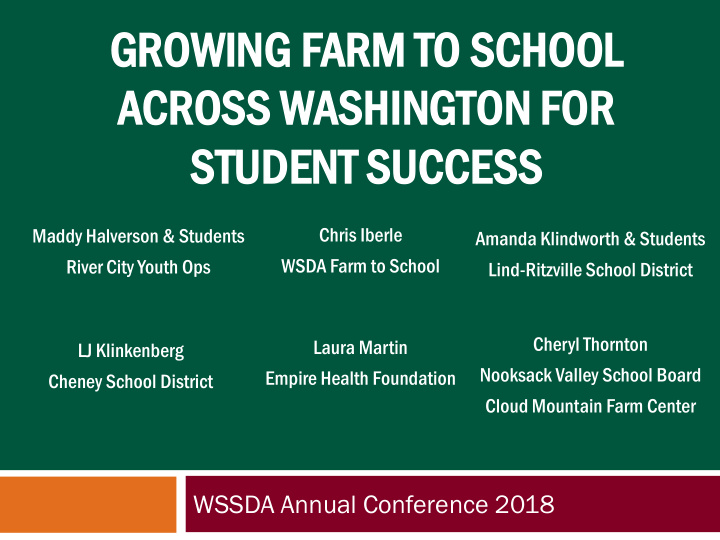



GR GROWIN OWING FARM RM TO S O SCHO CHOOL OL ACR CROSS WASHI HING NGTON ON FO FOR R STU TUDE DENT NT SUCC UCCESS SS Chris Iberle Maddy Halverson & Students Amanda Klindworth & Students WSDA Farm to School River City Youth Ops Lind-Ritzville School District Cheryl Thornton Laura Martin LJ Klinkenberg Nooksack Valley School Board Empire Health Foundation Cheney School District Cloud Mountain Farm Center WSSDA Annual Conference 2018
Session Overview Benefits of Farm to School Farm to School in practice School ol Ga Garden dens s & O & On-far arm m Educ ucation ation River City Youth Ops (Spokane) Procu curemen rement t & Promo omoti tion on in School ol Meals ls Cheney School District & Empire Health Foundation Cloud Mountain Farm Center (Everson) Class assroom oom Agric icult ulture ure Educati ation on Lind-Ritzville FFA (Lind) Getting Involved Q & A
Why farm to school? Students Increase of +0.99 to +1.3 servings of fruits and vegetables consumed Improves learning Enhances food & agriculture literacy Better health and future food choices
Why farm to school? School nutrition programs 3-16% increase in meal participation More learning opportunities Supports the local economy High quality, tasty food
Why farm to school? Farmers Improve student health Teach kids about agriculture Stable market and sales
Why farm to school?
Why farm to school?
Farm to School Benefits Community $0.60-$2.16 increase in economic activity for every $1 spent 1.67 jobs created for each farm to school job Increase in food security and healthy families Fun!
School Gardens and On-farm Education River City Youth Ops
Procurement & Promotion in Schools Cheney School District o Scratch cooking initiative introducing fresh foods in schools o That’s not a pear: Where does my food come from? o 2015 USDA Farm to School Planning Grant o Educator Newsletters, Special Taste Test Events, Posters, In-School promotions
Procurement & Promotion in Schools Cheney School District o Procurement Process: How do we select the foods we feature? o Role of kitchen, building and administrative staff in building a successful program o Farm to School’s impact on a food culture Teach kids how their food grows and where it comes from Have fun. Make it an adventure. Kids WILL eat healthy food
Inside this issue: fresh. delicious. local. Curriculum 2 Corner: Student Detective November 2016 Curriculum 2 Corner: Science Carrots Investigation Curriculum 2 Corner: History of the Carrot cut the leaves off as soon as they are HOW THEY Curriculum 3 out of the ground, because as long as Corner: Classroom GROW leaves are attached, they continue to Energizer grow and draw moisture and The part of the carrot that you eat A Slice of Nutrition 3 nourishment from the carrot. Carrots is a root that grows underground. are mechanically harvested with self- Above the soil you will only see a propelled multi-row harvesters that soft bunch of green leaves that can harvest up to 1,000 tons per day. Curriculum 3 look a bit like a fern — that is the Corner: Literature carrot top! Carrots grow best in Links cooler temperatures. In mild Curriculum 3 climates like Washington, farmers Corner: Just the plant seeds early in the spring. Facts Carrots seeds are planted right below the surface. A windy day can ruin the crop by blowing the seeds away! Most carrots are ready for harvesting in less than three months, and they can be picked anytime they are big enough to eat. It is important to HOME GROWN FACTS Washington State grows 10,000 acres of carrots per year, and There are two carrot types that are ranks second to California in the important to Washington growers: Imperator, also known as “ slicers ” and U.S. production of carrots . Chantenay, known as “ dicers. ” Slicers have long and slender roots, allowing them to be sold as fresh whole carrots. Dicers are short and thick which makes them popular for processing (diced up into other foods like a frozen meal or soup).
Cultivating a Different Kind of Student Lind-Ritzville Middle School Plant, Manage, Harvest, and Process CTE: Agribusiness Systems Student led, based on community needs Educational spaces Traditional classroom Greenhouse Shop Farm/garden Landscaping Kitchen
Lind-Ritzville Students
Support Food service staff Flexibility & Trust Professional development Curriculum Student Led weather stations, compost, eating seasonally student surveys/assessments (good teaching) Community Partnerships Grants
Getting Involved Find out what’s happening in your district Figure out what support they need Celebrate and promote successes Build partnerships for new initiatives Join and connect through the Washington State Farm to School Network
Districts with Farm to School activity
Jo Join n th the new e new Was ashingt hington on Stat ate e Far arm t m to Sc o Scho hool ol Netw twor ork! k! Farm to ECE Informal Public Educators Regional Hubs Agencies with member School Teachers contact info Nutrition 170+ Services Community School members Volunteers Gardeners Communities of Farms & Students Practice on farm Food Statewide coordination Non-profits & Industry to school topics on goals, impacts, and Parents Advocacy evaluation For more re info: : waf2sne snetw twor ork@gm k@gmail.c ail.com om Sign gn up at: tinyurl.c yurl.com/w om/waf af2sne 2snetw twor ork Or at the WS WSDA A Farm rm to Schoo chool l table ble
We’re here to help Chris is Iber erle ciberle@agr.wa.gov (206) 256-1874 wafarmtoschool.org
Recommend
More recommend